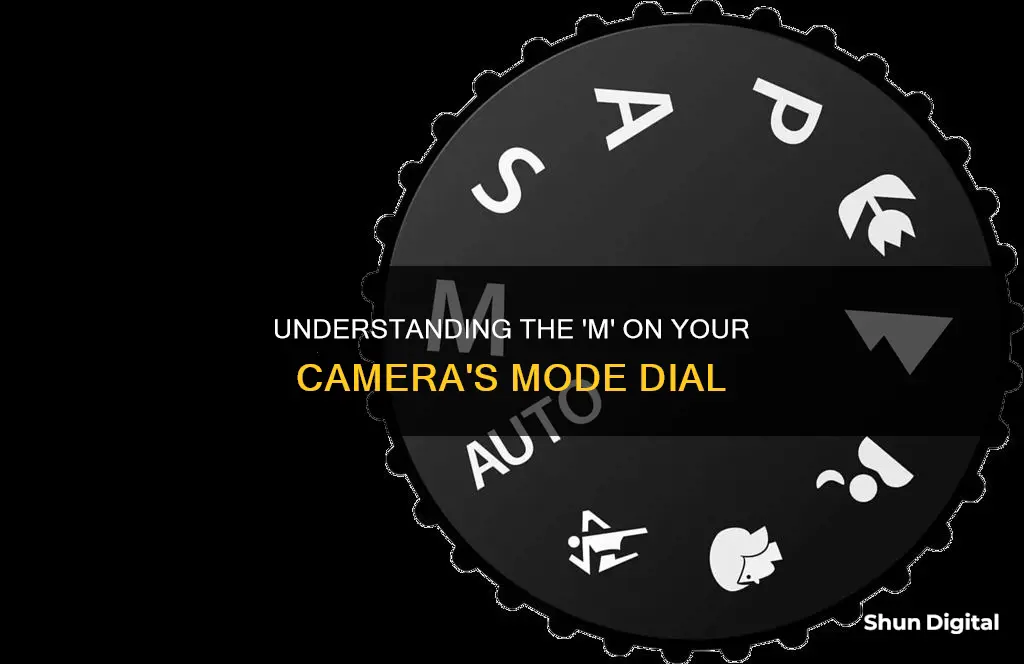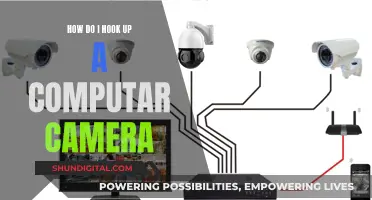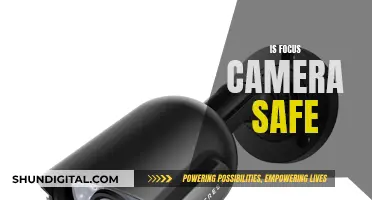
The mode dial on a camera is one of the most important parts, as it gives you access to the shooting modes. The M on the mode dial stands for Manual mode, which means that all settings are done manually. In Manual mode, the photographer has control over shutter speed, aperture, and ISO independently. This is considered the most complex of all the camera modes because it gives the photographer full control over each and every setting.
| Characteristics | Values |
|---|---|
| Mode | Manual (M) |
| Access | Manual settings |
| Control | Shutter speed, aperture and ISO |
What You'll Learn

M stands for 'Manual' mode, where the photographer controls shutter speed, aperture and ISO
M stands for Manual mode, where the photographer controls shutter speed, aperture and ISO. This is the mode that gives the photographer the most control over the camera.
Manual mode is the most complex of all the camera modes, as it gives the photographer full control over each and every setting. While the camera will offer exposure suggestions, the photographer must carefully select the aperture, shutter speed, and ISO. Shooting in Manual mode can be a little scary at first, but it is also intensely rewarding as it allows the photographer to get precisely the picture they want.
In Manual mode, the photographer can use any combination of shutter speed, aperture, and ISO to get the desired result. This means that the photographer can choose a fast shutter speed to freeze motion, or a slow shutter speed to create motion blur. They can also choose a wide aperture to create a shallow depth of field, or a narrow aperture for a deeper depth of field. In addition, the photographer can adjust the ISO to make the image brighter or darker.
Manual mode is challenging and requires a good understanding of how the camera works, but it is a great way to learn about the different settings and how they affect the final image. It is recommended to practice shooting in Manual mode in slower-paced scenarios to get comfortable with the settings before trying to capture fast-moving subjects or challenging lighting conditions.
While Manual mode gives the photographer the most control, it can also be a slow process to dial in the settings. If the scene is changing quickly, it can be easy to miss the shot. Therefore, it is important to know when to use Manual mode and when to use one of the other semi-automatic modes, such as Aperture Priority or Shutter Priority, which give the photographer control over one or two settings while the camera calculates the rest.
Mastin Labs and Adobe Camera Raw: A Perfect Match?
You may want to see also

Manual mode is the most complex camera mode
The 'M' on the camera mode dial stands for Manual mode. This is the most complex camera mode because it gives the photographer complete control over all the camera settings.
Manual mode is the most complex because it allows you to control the three key exposure variables: ISO, aperture, and shutter speed. These settings determine the overall brightness of your photos, as well as the sharpness, depth of field, and overall quality of your files.
ISO controls your camera’s sensitivity to light. A higher ISO will give you a brighter image, but it will also increase the noise in your photo. Aperture is the opening in the lens that lets in light. A wider aperture will let in more light and create a shallower depth of field, resulting in a blurry background. Shutter speed refers to the amount of time the shutter stays open to allow light to hit the sensor. A faster shutter speed will result in a darker image and will generally produce sharper images, while a slower shutter speed will result in a brighter image and may produce motion blur.
In addition to these three key settings, Manual mode also allows you to adjust the white balance, which can be used to remove colour casts from your scene and achieve neutral white tones.
While Manual mode offers a lot of flexibility, it can be intimidating and time-consuming, especially for beginners. It requires a basic understanding of the exposure triangle and is best suited for situations with unchanging lighting conditions where you have time to carefully adjust your settings. If you are dealing with fast-paced conditions and changing light, or you are not yet experienced with photography, it is often better to use a semi-automatic mode such as Aperture Priority or Shutter Priority.
Raw Files: Easy Edits, Better Photos
You may want to see also

The photographer has full creative control in Manual mode
The 'M' on the camera mode dial stands for Manual mode, which gives the photographer full creative control over the camera settings. In Manual mode, the photographer has to carefully select the aperture, shutter speed, and ISO, allowing them to make precise adjustments to get the desired shot. While this mode can be challenging and a little scary at first, it is incredibly rewarding as it empowers photographers to capture precisely the picture they want.
Manual mode is distinct from other modes, such as Aperture Priority (A or Av) and Shutter Priority (S or Tv), where the photographer only has control over one aspect of the exposure settings. In Aperture Priority, the photographer controls the aperture to determine the depth of field, while the camera automatically selects the shutter speed. Conversely, in Shutter Priority, the photographer chooses the shutter speed to capture motion or freeze action, and the camera calculates the appropriate aperture. These semi-automatic modes offer a balance between creative control and convenience, allowing photographers to focus on specific aspects of their images without worrying about the rest.
However, Manual mode goes beyond these modes by granting the photographer full autonomy over all settings. This means that in addition to adjusting the aperture and shutter speed, the photographer also sets the ISO, which affects the camera's sensitivity to light. While this level of control can be daunting, it is an excellent tool for photographers who want to fine-tune their images and develop their skills. It is particularly useful in situations where the photographer wants to deviate from the camera's automatic settings, such as when shooting in low light or creating long exposures.
Manual mode is an excellent learning tool as it encourages photographers to understand the exposure triangle and how different settings interact to achieve the desired exposure. By monitoring the exposure bar in the viewfinder and making careful adjustments, photographers can develop a deeper understanding of their craft. While it may take practice and patience, mastering Manual mode can be intensely liberating, providing photographers with the creative freedom to capture unique and exceptional images.
Battery Chargers: Are They Included With Cameras?
You may want to see also

Manual mode is challenging but rewarding
The "M" on the camera mode dial stands for "Manual" mode, which allows the photographer to control the shutter speed, aperture, and ISO independently. Manual mode is challenging, especially for beginners, but it can be rewarding. Here's why:
Manual mode gives you full creative control over your camera's settings, allowing you to capture images that match your creative vision. You can prioritize elements within a photo, such as depth of field, exposure, and focus. This mode is particularly useful when you want to achieve specific effects, like bokeh (background blur) or motion blur for artistic purposes.
However, with great power comes great responsibility. In Manual mode, you are responsible for adjusting the aperture, ISO, and shutter speed to achieve the desired exposure. This can be challenging, especially in dynamic lighting conditions or when trying to capture fleeting moments. You'll need to understand the exposure triangle and how each setting impacts your image.
For example, a small aperture (high f-stop number) will result in a larger depth of field, keeping both the foreground and background in focus. However, this requires more light for a proper exposure, so you'll need to adjust either the shutter speed or ISO accordingly. A faster shutter speed can help freeze motion, while a slower shutter speed can create motion blur or light trails, depending on the lighting conditions.
Manual mode also demands more time and attention from you as a photographer. You'll need to analyze the scene, decide what should be in focus, and make deliberate choices about your settings. This process can slow you down, especially when compared to the convenience of Auto modes.
However, the challenge of Manual mode is also its greatest reward. By taking the time to understand and master Manual mode, you'll develop a deeper understanding of photography fundamentals. You'll learn how to meter a scene, adjust your settings accordingly, and make better use of semi-Auto or full Auto modes when needed. Ultimately, you'll become a more skilled and confident photographer, capable of capturing the images you truly want.
So, while Manual mode may seem daunting at first, it's worth investing the time to learn and practice. The rewards of creative control, technical mastery, and improved photography skills make it well worth the effort.
Understanding Your Camera's RAW Settings
You may want to see also

Manual mode is good for certain scenarios, like astrophotography
The "M" on a camera mode dial stands for "Manual mode". This mode gives the photographer complete control over the camera settings, including the shutter speed, aperture, and ISO. While it can be intimidating to use at first, it offers a lot of flexibility that other camera modes cannot match.
- Control over settings: Astrophotography often requires specific settings, such as a wide aperture, high ISO, and long exposure times. In Manual mode, photographers can independently adjust these settings to get the desired results.
- Low-light performance: In dark environments, such as when photographing the night sky, Manual mode allows for increased light sensitivity by adjusting the ISO and aperture settings. This results in brighter images.
- Long exposure: Astrophotography often involves capturing light trails, such as star trails, which require long exposure times. Manual mode gives photographers the ability to slow down the shutter speed and keep the shutter open for longer periods, capturing more light.
- Focus control: In astrophotography, it is crucial to achieve accurate focus on distant objects, such as stars or galaxies. Manual mode, combined with manual focus, allows photographers to fine-tune the focus to ensure sharp and clear images.
- Creative effects: Astrophotography often involves creating artistic effects, such as motion blur or light trails. Manual mode provides control over shutter speed and aperture, allowing photographers to experiment and achieve their desired creative vision.
While Manual mode is excellent for astrophotography, it may not be suitable for all scenarios. It is best avoided when the lighting conditions are changing rapidly or when photographing moving subjects. In such cases, semi-automatic modes, like Aperture Priority or Shutter Priority, may be more appropriate.
The Power of Battery Holders for Cameras
You may want to see also
Frequently asked questions
The M stands for Manual mode, which gives the photographer full control over the camera settings.
In Manual mode, the photographer has to set the camera settings manually, including the shutter speed, aperture, and ISO.
In Semi-automatic modes like Aperture Priority (Av or A) and Shutter Priority (Tv or S), the photographer can control one or two settings, and the camera will automatically adjust the rest. In Auto mode, the camera controls and adjusts all the settings.
Manual mode is great for situations where you want full creative control over your camera and the lighting conditions are consistent. It is also useful for specific scenarios like astrophotography or long exposures. However, it can be slow and cause you to miss shots in fast-paced situations.
Learning to shoot in Manual mode can be daunting, but understanding the exposure triangle and carefully monitoring the exposure bar in the viewfinder will help you arrive at the correct exposure. Practicing in slower-paced scenarios will also make it easier to get comfortable with Manual mode.







